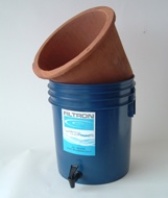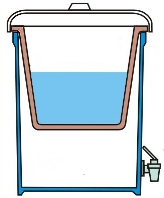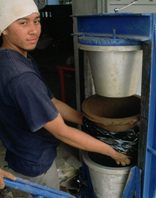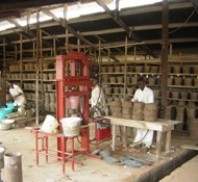Difference between revisions of "Ceramic pot filter"
| Line 1: | Line 1: | ||
__NOTOC__ | __NOTOC__ | ||
| − | |||
| − | |||
| − | |||
| − | |||
| − | |||
| − | |||
| − | |||
| − | |||
| − | |||
| − | |||
| − | |||
| − | |||
| − | |||
| − | |||
| − | |||
| − | |||
| − | |||
[[Image:CPF1.jpg|thumb|right|150px| Potters for Peace filter model.]] | [[Image:CPF1.jpg|thumb|right|150px| Potters for Peace filter model.]] | ||
| Line 23: | Line 6: | ||
[[Image:CPF4.jpg|thumb|right|150px| Small local filter factory.]] | [[Image:CPF4.jpg|thumb|right|150px| Small local filter factory.]] | ||
| − | |||
Locally produced ceramics have been used to filter water for hundreds of years. Water is poured into a porous ceramic filter pot, and is collected in another container after it passes through the ceramic pot. | Locally produced ceramics have been used to filter water for hundreds of years. Water is poured into a porous ceramic filter pot, and is collected in another container after it passes through the ceramic pot. | ||
| Line 34: | Line 16: | ||
Colloidal silver is sometimes applied to the ceramic pot after firing or added to the clay mixture prior to firing. Colloidal silver is an antibacterial which helps in pathogen removal, as well as preventing growth of bacteria within the filter itself. Some ceramic pot filters also include activated charcoal in the clay mixture to improve odour, taste, and colour. | Colloidal silver is sometimes applied to the ceramic pot after firing or added to the clay mixture prior to firing. Colloidal silver is an antibacterial which helps in pathogen removal, as well as preventing growth of bacteria within the filter itself. Some ceramic pot filters also include activated charcoal in the clay mixture to improve odour, taste, and colour. | ||
| + | Pathogens and suspended material are removed from water through a combination of biological and physical processes. | ||
| + | |||
| + | Quality control on the size of the combustible materials used in the clay mix ensures that the filter pore size is small enough to prevent contaminants from passing through the filter. Colloidal silver aids treatment by breaking down pathogens’ cell membranes, causing them to die. | ||
| + | |||
| + | ==History and social context== | ||
150,000 filters are used in Central America, Asia and Africa. | 150,000 filters are used in Central America, Asia and Africa. | ||
| Line 40: | Line 27: | ||
In Nicaragua, Guatemala and Cambodia the production of this filter is a commercial activity and production is starting up in six other countries. | In Nicaragua, Guatemala and Cambodia the production of this filter is a commercial activity and production is starting up in six other countries. | ||
| − | == | + | ==Suitable conditions == |
| − | + | The ceramic pot filter is suitable to process 8 litres of water per batch. This produces a daily water supply of 20-30 litres. | |
| + | |||
| + | {{Potential_Treatment_Capacity_table | ||
| + | | highly= | ||
| + | - Bacteria<br> | ||
| + | - Protozoa<br> | ||
| + | - Helminths<br> | ||
| + | - Turbidity<br> | ||
| + | - Taste/odour/colour | ||
| + | | somewhat= | ||
| + | - Viruses<br> | ||
| + | - Iron<br> | ||
| + | | not= | ||
| + | - Dissolved Chemicals | ||
| + | | process=Filtration | ||
| + | | watcrit=Turbidity < 50 NTU | ||
| + | }} | ||
| − | + | ==Technical specification== | |
| − | ==Operation== | + | ====Operation==== |
Contaminated water is poured into the ceramic pot. The water slowly passes through the pores and is collected in the lower container. The treated water is stored in the container until needed, protecting it from recontamination. The user simple opens the tap at the base of the container when they need water. | Contaminated water is poured into the ceramic pot. The water slowly passes through the pores and is collected in the lower container. The treated water is stored in the container until needed, protecting it from recontamination. The user simple opens the tap at the base of the container when they need water. | ||
For turbidity levels greater than 50 NTU, the water should first be strained through a cloth or sedimented before using the ceramic filter. | For turbidity levels greater than 50 NTU, the water should first be strained through a cloth or sedimented before using the ceramic filter. | ||
| − | The | + | The estimated flow rate is 1-3 litres/hour. This is highest when the pot is full. It declines with use and accumulation of contaminants within the filter pores. |
| − | ==Treatment | + | ====Treatment Efficiency==== |
{{Treatment_Efficiency | {{Treatment_Efficiency | ||
|lab:bacteria=>98-100 % <ref name=Lantagne>[[#Lantagne01|Lantagne]] (2001)</ref><ref name=Smith>[[#Smith04|Smith]] (2004)</ref> | |lab:bacteria=>98-100 % <ref name=Lantagne>[[#Lantagne01|Lantagne]] (2001)</ref><ref name=Smith>[[#Smith04|Smith]] (2004)</ref> | ||
| Line 73: | Line 76: | ||
Treatment efficiencies provided in the above table require colloidal silver. The treatment efficiency is also affected by pore size and construction quality. Taste, odour and colour of filtered water is generally improved. | Treatment efficiencies provided in the above table require colloidal silver. The treatment efficiency is also affected by pore size and construction quality. Taste, odour and colour of filtered water is generally improved. | ||
| + | ====Maintenance==== | ||
| + | It is recommended that the filter pot be replaced every 1-2 years. This is in part to protect against fine cracks which may have developed and are not be visible. Any cracks will reduce the effectiveness since water can short-circuit through the crack without being filtered through the ceramic pores. | ||
| − | + | There are no moving or mechanical parts to break in the ceramic pot filter. Small cracks can occur which are not visible to the naked eye, but which allow pathogens to pass through the filter. Poor transportation of filters can lead to cracking and/or breakage. Plastic taps in the lower container can break, metal taps last longer but increase cost. | |
| − | |||
| − | |||
| − | |||
| − | + | A supply chain and market availability for replacement filters and taps is required. A quality control process is required to ensure filter effectiveness. Recontamination is possible during cleaning; care should be taken to use clean water, not to touch the ceramic with dirty hands, and not to place the filter on a dirty surface. | |
| − | |||
| − | + | Filters are cleaned by lightly scrubbing the surface when the flow rate is reduced. Some manufacturers recommend to boil the filter every three months to ensure effectiveness. Some manufacturers recommend that soap and chlorine should not be used to clean the filter. The lower container, tap and lid should be cleaned on a regular basis. | |
| − | |||
| − | |||
| − | |||
| − | |||
| − | |||
| − | |||
| − | |||
| − | |||
| − | |||
| − | |||
| − | |||
| − | + | ====Manufacturing==== | |
| + | Local production of the filters is common and preferable. A quality control process to ensure filter effectiveness is required. The lower container, lid and tap can usually be purchased locally. | ||
| − | + | Materials and facilities required are: | |
* Clay | * Clay | ||
* Combustible material (e.g. sawdust, rice husks, coffee husks) | * Combustible material (e.g. sawdust, rice husks, coffee husks) | ||
| Line 103: | Line 94: | ||
* Lid | * Lid | ||
* 20-30 litre ceramic or plastic container with tap | * 20-30 litre ceramic or plastic container with tap | ||
| − | |||
| − | |||
* A ceramic factory requires at least 100 m<sup>2</sup> of covered area | * A ceramic factory requires at least 100 m<sup>2</sup> of covered area | ||
* 15 to 20 ton hydraulic press (can be fabricated locally) | * 15 to 20 ton hydraulic press (can be fabricated locally) | ||
| Line 115: | Line 104: | ||
* Miscellaneous tools (e.g. traditional pottery tools) | * Miscellaneous tools (e.g. traditional pottery tools) | ||
| − | + | A professional potter with experience in collecting clay, making ceramic articles, semi-industrial or mass production is required. Assistants, preferably potters are required. Skill and quality control in manufacturing is essential to ensure optimum pore size, flow rate and effectiveness. | |
| − | A professional potter with experience in collecting clay, making ceramic articles, semi-industrial or mass production is required. Assistants, preferably potters are required. Skill and quality control in manufacturing is essential to ensure optimum pore size, flow rate and effectiveness. | ||
| − | + | Working with presses and kilns is potentially hazardous and adequate safety precautions should be used. | |
| − | Working with presses and kilns is potentially hazardous and adequate safety precautions should be used. | + | |
| + | ====Estimated Lifespan==== | ||
| + | The estimated lifespan is up to 5 years, but is generally 1-2 years. The filter needs to be replaced if there are visible cracks. | ||
| − | == | + | ====Suppliers==== |
| − | + | Free press and kiln designs are available from Potters for Peace. | |
==Cost== | ==Cost== | ||
| Line 135: | Line 125: | ||
Cost of introduction: US$ 15,000 - 30,000 for project incl. training, machinery and a first production of 500 filters. US$ 50,000 - 100,000 for project incl. production shop, training, first promotion, and 5,000 filters. | Cost of introduction: US$ 15,000 - 30,000 for project incl. training, machinery and a first production of 500 filters. US$ 50,000 - 100,000 for project incl. production shop, training, first promotion, and 5,000 filters. | ||
| + | |||
| + | ==Country experiences== | ||
| + | |||
| + | ==Manuals== | ||
| + | * [http://s189535770.onlinehome.us/pottersforpeace/?page_id=125 Complete production manual is available from Potters for Peace] | ||
==Movies== | ==Movies== | ||
| Line 141: | Line 136: | ||
* Panel Discussion English [http://video.google.com/videoplay?docid=6838040406197916953&hl=en video.google.com/videoplay?docid=6838040406197916953&hl=en ] | * Panel Discussion English [http://video.google.com/videoplay?docid=6838040406197916953&hl=en video.google.com/videoplay?docid=6838040406197916953&hl=en ] | ||
| − | ==External | + | ==External Links== |
*[http://www.cdc.gov/safewater/publications_pages/options-ceramic.pdf Centers for Disease Control and Prevention] | *[http://www.cdc.gov/safewater/publications_pages/options-ceramic.pdf Centers for Disease Control and Prevention] | ||
*[http://www.filterpurefilters.org Filter Pure, Inc] | *[http://www.filterpurefilters.org Filter Pure, Inc] | ||
| Line 149: | Line 144: | ||
==Footnotes== | ==Footnotes== | ||
<references/> | <references/> | ||
| + | |||
==References== | ==References== | ||
| Line 158: | Line 154: | ||
* Van Halem, D. (2006) Ceramic silver impregnated pot filters for household drinking water treatment in developing countries. Masters of Science in Civil Engineering Thesis, Department of Water Resources, Delft University of Technology, Netherlands. | * Van Halem, D. (2006) Ceramic silver impregnated pot filters for household drinking water treatment in developing countries. Masters of Science in Civil Engineering Thesis, Department of Water Resources, Delft University of Technology, Netherlands. | ||
* Vinka, A. et al. (2007) Sustainable Colloidal-Silver-Impregnated Ceramic Filter for Point-of-Use Water Treatment, Environmental Science & Technology, Vol. 42, No. 3, 927–933 | * Vinka, A. et al. (2007) Sustainable Colloidal-Silver-Impregnated Ceramic Filter for Point-of-Use Water Treatment, Environmental Science & Technology, Vol. 42, No. 3, 927–933 | ||
| + | |||
| + | {{Joinus}} | ||
Revision as of 10:14, 28 July 2009
Locally produced ceramics have been used to filter water for hundreds of years. Water is poured into a porous ceramic filter pot, and is collected in another container after it passes through the ceramic pot.
Ceramic pot filters usually have a diameter of about 30 cm by 25 cm deep, with an 8 litre capacity. Two variations of ceramic filters, flat-bottom and round-bottom, are currently manufactured.
The ceramic pot typically sits or hangs in the top of a larger plastic or ceramic container (20-30 litres), which is fitted with a tap at the bottom. A lid is placed on top of the filter to prevent contamination. This system both treats the water and provides safe storage of the treated water until it is used.
Ceramic pots are usually made from local clay mixed with a combustible material like sawdust, rice husks or coffee husks. The clay and combustible material are sieved through a fine mesh, and then mixed together with water until it forms a homogeneous mixture. The mixture is pressed into shape using a mold. When the pot is fired in a kiln, the combustible material burns out, leaving a network of fine pores through which the water can flow through.
Colloidal silver is sometimes applied to the ceramic pot after firing or added to the clay mixture prior to firing. Colloidal silver is an antibacterial which helps in pathogen removal, as well as preventing growth of bacteria within the filter itself. Some ceramic pot filters also include activated charcoal in the clay mixture to improve odour, taste, and colour.
Pathogens and suspended material are removed from water through a combination of biological and physical processes.
Quality control on the size of the combustible materials used in the clay mix ensures that the filter pore size is small enough to prevent contaminants from passing through the filter. Colloidal silver aids treatment by breaking down pathogens’ cell membranes, causing them to die.
History and social context
150,000 filters are used in Central America, Asia and Africa.
CARE, UNICEF, Red Cross amongst others use the filter.
In Nicaragua, Guatemala and Cambodia the production of this filter is a commercial activity and production is starting up in six other countries.
Suitable conditions
The ceramic pot filter is suitable to process 8 litres of water per batch. This produces a daily water supply of 20-30 litres.
|
|
Technical specification
Operation
Contaminated water is poured into the ceramic pot. The water slowly passes through the pores and is collected in the lower container. The treated water is stored in the container until needed, protecting it from recontamination. The user simple opens the tap at the base of the container when they need water.
For turbidity levels greater than 50 NTU, the water should first be strained through a cloth or sedimented before using the ceramic filter.
The estimated flow rate is 1-3 litres/hour. This is highest when the pot is full. It declines with use and accumulation of contaminants within the filter pores.
Treatment Efficiency
| Bacteria | Viruses | Protozoa | Helminths | Turbidity | Iron | {{{extra_Field}}} | |
|---|---|---|---|---|---|---|---|
| Laboratory | >98-100 % 12 | 19-99% 1 34 | Up to 100% 5 | up to 100% 5 | 83-99% 16 | not available | - |
| Field | 88 - >95.1% 27 | not available | Up to 100% 5 | Up to 100% 5 | <5 NTU 2 | >90% 6 | - |
Treatment efficiencies provided in the above table require colloidal silver. The treatment efficiency is also affected by pore size and construction quality. Taste, odour and colour of filtered water is generally improved.
Maintenance
It is recommended that the filter pot be replaced every 1-2 years. This is in part to protect against fine cracks which may have developed and are not be visible. Any cracks will reduce the effectiveness since water can short-circuit through the crack without being filtered through the ceramic pores.
There are no moving or mechanical parts to break in the ceramic pot filter. Small cracks can occur which are not visible to the naked eye, but which allow pathogens to pass through the filter. Poor transportation of filters can lead to cracking and/or breakage. Plastic taps in the lower container can break, metal taps last longer but increase cost.
A supply chain and market availability for replacement filters and taps is required. A quality control process is required to ensure filter effectiveness. Recontamination is possible during cleaning; care should be taken to use clean water, not to touch the ceramic with dirty hands, and not to place the filter on a dirty surface.
Filters are cleaned by lightly scrubbing the surface when the flow rate is reduced. Some manufacturers recommend to boil the filter every three months to ensure effectiveness. Some manufacturers recommend that soap and chlorine should not be used to clean the filter. The lower container, tap and lid should be cleaned on a regular basis.
Manufacturing
Local production of the filters is common and preferable. A quality control process to ensure filter effectiveness is required. The lower container, lid and tap can usually be purchased locally.
Materials and facilities required are:
- Clay
- Combustible material (e.g. sawdust, rice husks, coffee husks)
- Colloidal silver (optional)
- Lid
- 20-30 litre ceramic or plastic container with tap
- A ceramic factory requires at least 100 m2 of covered area
- 15 to 20 ton hydraulic press (can be fabricated locally)
- Filter molds (can be fabricated locally)
- Mixer for clay and combustible material (can be fabricated locally)
- Hammer mill (can be fabricated locally)
- Kiln with an internal area of at least 1 cubic metre (can be fabricated locally)
- Racks
- Work benches
- Miscellaneous tools (e.g. traditional pottery tools)
A professional potter with experience in collecting clay, making ceramic articles, semi-industrial or mass production is required. Assistants, preferably potters are required. Skill and quality control in manufacturing is essential to ensure optimum pore size, flow rate and effectiveness.
Working with presses and kilns is potentially hazardous and adequate safety precautions should be used.
Estimated Lifespan
The estimated lifespan is up to 5 years, but is generally 1-2 years. The filter needs to be replaced if there are visible cracks.
Suppliers
Free press and kiln designs are available from Potters for Peace.
Cost
| Captial Cost | Operation Cost | Replacement Cost | Estimated 5 years Cost | Cost/liter treated |
|---|---|---|---|---|
| US$ 12-25 | US$ 0 | US$ 4 | US$ 18-31 | US$ ~0.001 |
Note: Program, transportation and education costs are not included.
Cost of introduction: US$ 15,000 - 30,000 for project incl. training, machinery and a first production of 500 filters. US$ 50,000 - 100,000 for project incl. production shop, training, first promotion, and 5,000 filters.
Country experiences
Manuals
Movies
- construction video nl.youtube.com/watch?v=JSBU-MLwDmk&feature=related
- Explanation Espanol www.youtube.com/watch?v=-2c2bmg7yCM
- Panel Discussion English video.google.com/videoplay?docid=6838040406197916953&hl=en
External Links
- Centers for Disease Control and Prevention
- Filter Pure, Inc
- Potters for Peace
- www.ceramicatamakloe.com
Footnotes
- ↑ 1.0 1.1 1.2 Lantagne (2001)
- ↑ 2.0 2.1 2.2 Smith (2004)
- ↑ Van Halem(2006)
- ↑ Some additives to the clay may increase virus removal.
- ↑ 5.0 5.1 5.2 5.3 Not researched, however helminths and protazoa are too large to pass between the 0.6-3 μm pores. Therefore, up to 100% removal efficiency can be assumed.
- ↑ 6.0 6.1 Low(2002)
- ↑ Brown and Sobsey(2006)
References
- Brown, J. and M. Sobsey (2006) Independent Appraisal of Ceramic Water Filtration Interventions in Cambodia: Final Report, Department of Environmental Sciences and Engineering, School of Public Health, University of North Carolina, USA.
- Lantagne, D. (2001) Investigation of the Potters for Peace Colloidal Silver Impregnated Ceramic Filter Report 2: Field Investigations. Alethia Environmental for USAID, USA.
- Low, J. (2002). Appropriate Microbial Indicator Tests for Drinking Water in Developing Countries and Assessment of Ceramic Water Filters’, Master of Engineering thesis. Department of Civil and Environmental Engineering, Massachusetts Institute of Technology. Cambridge, Massachusetts, USA.
- Napotnik, J., Mayer, A., Lantagne, D. and K. Jellison (Efficacy of Silver-Treated Ceramic Filters for Household Water Treatment. Department of Civil and Environmental Engineering, Lehigh University, USA. Available at: www.filterpurefilters.org/files/pdf/silver.pdf
- Smith, L. (2004) Ceramic Water Filter Use in Takeo, Cambodia – Operational Issues and Health Promotion Recommendations. Submitted in partial fulfilment as a requirement for a Master of Science in Control of Infectious Diseases, London School of Hygiene and Tropical Medicine, London, England.
- Van Halem, D. (2006) Ceramic silver impregnated pot filters for household drinking water treatment in developing countries. Masters of Science in Civil Engineering Thesis, Department of Water Resources, Delft University of Technology, Netherlands.
- Vinka, A. et al. (2007) Sustainable Colloidal-Silver-Impregnated Ceramic Filter for Point-of-Use Water Treatment, Environmental Science & Technology, Vol. 42, No. 3, 927–933
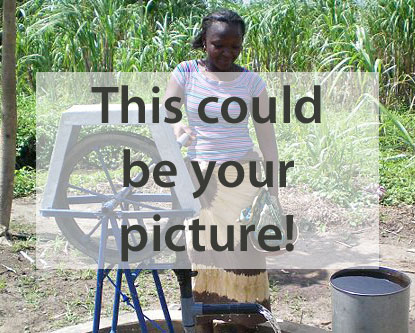
|
